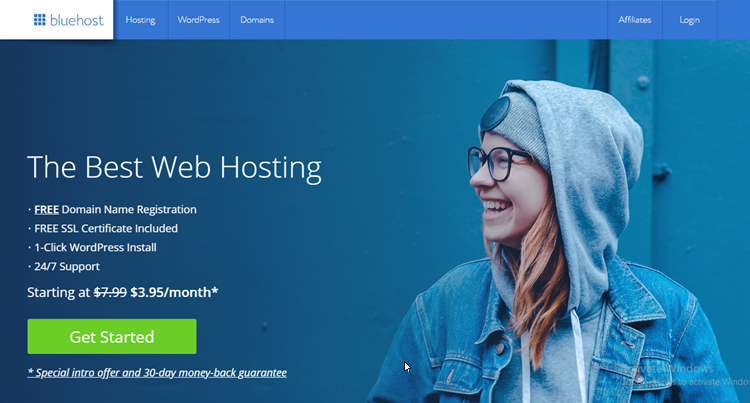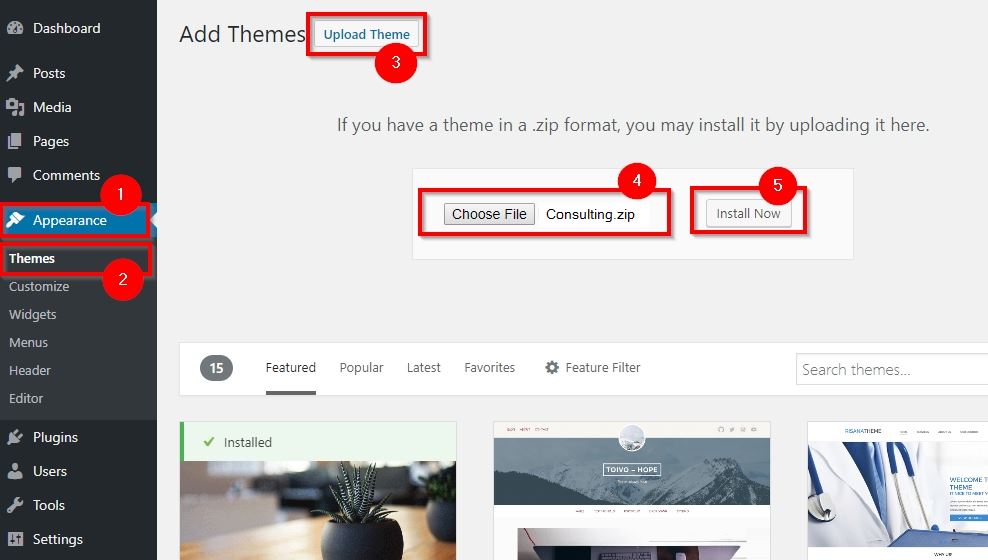If you are a local business owner, you should make small business website to create an online presence.
These small business websites do not just represent your business online, but also helps you with competitive advantages, improves the scope of your business beyond the geographical area and helps promote your services better.
Besides there are innumerable advantages of creating a small business website.
1) Initial steps: Domain name and Hosting
2) Installing WordPress and the theme
3) Customizing your website and initial setup
4) Promoting your small business website
5) Small business website Maintenance
1) Initial steps: Domain name and Hosting
To start with your website building, you must first acquire the domain name and hosting. Fortunately, there are a number of domain name registrars and hosting service providers you can choose from.
The domain name is assigned to your numeric internet address that makes it easier to memorize. The process to register a domain name is quite simple

- Go to the domain name registrar of your choice – There are many domain name registrars like Godaddy, NameCheap, or Bluehost. We recommend Bluehost for your domain name and hosting.
- Use the search bar to search for the domain name. Here are some basic tips about choosing a domain name. When picking a domain name, make sure that you come up with two or three names for your website. So if the one you choose is unavailable, you can try the other alternatives.
- Once you find a domain name of your choice is available, click add to cart. You may be asked for some other services, but you can make the choices and check out easily.
- You will need an account to check out. The details about your domain name will be sent to your registered email address.
Choosing the hosting service
- Visit the website of your chosen hosting service
- Choose the plan that best fits your requirements
- Sign up for that service with the regular registration and signing up process.
Connecting Domain name to hosting
- Log into your cPanel.
- There are different arrangement of options and navigational paths for adding the domains. Typically, you will find an add Domains, located under the Domains section.
- Enter in the domain in the New Domain Name section.
- Click Add Domain
All the steps mentioned above may not be common for all the hosting companies. Your host may have different ways to setup and use the hosting space and domain name.
However, they must provide you with the documentation or video tutorials to help you do so. With these steps performed, we’ll start with installing the essential software for website building.
2) Installing WordPress and the theme
 One of the most important choice while you decide to make a small business website is choosing the platform you want to build your website on.
One of the most important choice while you decide to make a small business website is choosing the platform you want to build your website on.
Many things are impacted by the platform you choose for building your small business website. Here are some tips to choose a website builder for your small business website.
However, in this post, we will use WordPress for creating our small business website. WordPress because…
- It is easy to use
- It is free and open source
- There are so many themes you can choose from
- To extend the features of your website, you can use WordPress Plugins
- WordPress themes and plugins are easily available, there are a lot of choices to choose from and are affordable
- Managing the websites built with WordPress is easy too
- WordPress is SEO friendly
- It is a CMS that manages your content, everything can be controlled without touching a line of code
- With the page builders, you can even design your own pages, without possessing any designing experience
Besides, there are plenty of other reasons for choosing WordPress over other website building platform.
Once, you have decided on WordPress to build your website, you need to pick a theme that you would like to use for your website.
Choosing A WordPress Theme
WordPress themes are more than just design templates. They come with multi page design, functionalities, and even with multiple demo options.
They are just like a ready to use website – all you need to do is remove the sample data that the theme is populated with, and replace it with original content for your website.
And customizing these templates, is usually very easy. You can change how your website built with WordPress looks and behaves, just by the available options and setting.
You can use one of these free themes to start with. The free themes, however, come with limited options and features. But they can help you get familiar with the WordPress dashboard and the options.
To create professional, fully functional website with good SEO value, you will need to pick a premium WordPress theme.

In this post, I will use the Consulting WordPress theme to demonstrate how to create a small business website.
Consulting theme is perfect for the business owners without any website building experience to create their own website. It is easy to use and multipurpose. You can use the theme to create any kind of business website.
It is built with Elementor page builder, which makes it totally redesign-able. You can use the drag and drop options of the page builder and the Elementor modules to create the design of your choice. Even editing the pages is very easy.
You can easily register and buy the theme from our theme store.
Similarly, if you choose any other theme – you can register and buy that theme from the respective website.
The downloaded theme will be in a zip format. This is the zip folder that you can install into your WordPress setup. But before we proceed with that, you need to setup WordPress.
Setting up WordPress
Today, most of the hosting providers come with the feature to automatically install the latest WordPress version on your server.
You can just log in to your hosting cpanel, choose to create a website, and choose the option to “Build with WordPress”.
There are different processes to install and use WordPress for different hosting services, but it will always be a simple, easy process. If the above mentioned steps don’t work for your hosting service, you can contact the hosting support or find the solution in their documentation/user guide.
When starting with WordPress, you will be allowed to choose the language, then fill a small form to describe your website and choose your username and password, allowed to name your database.
Once your WordPress is ready, you can log in using the chosen user name and password to access the dashboard.
Installing the theme
The process to install the theme is simple. Log in to your WordPress dashboard >> Appearance >> Themes >> Add New >> Browse file & choose the theme zip you just downloaded.

The theme’s installation process vary from theme to theme. However, when you get yourself a premium theme like the consulting WordPress theme, you get a detailed documentation.
The documentation will help you with the installation and post-installation(if any) steps.
Your WordPress theme will most probably come with demo designs, or sample data that you can install and turn your website fully functional with pages created, widgets arranged and so on.
The consulting WordPress theme comes with an installation wizard that assists you and automatically installs the theme, the demo data and the plugins required for the theme to function. You can even integrate more plugins on your business website to add more features.
At the end of the wizard, you will have a website with example data, that you can start editing right away.
3) Customizing your small business website
WordPress templates are ready to use. They are predesigned and mostly pre programmed.
However, no shoe fits all. For your business’ website, you will need to customize it.
In order to personalize your website, so that it can represent your business online, you can use the options available at the theme’s back end.
Even though the theme customization steps are different for different themes, here we have listed out the logical and the most important steps for customizing your small business website:
Creating the pages you need
What is a website without some useful web pages?
Different web pages on your website should deliver different messages. So while personalizing your website, we will start with creating different web pages.
Some of the most common pages you will need on a small business website are:
About Us page: Where you can tell the visitors about your business. It includes: business history, business values, can also include personal details about the owner and how the business started.
Contact page: This is the page where you will display your contact details: phone number, email address, physical location of the business, and design a contact form through which the visitor can send you a message.
Service pages: For a business website, the service pages are the pages to describe your services. It can be a single page that lists all the services with a brief overview, followed by a dedicated service page for each service that you offer. More about designing service pages.
Portfolio/Gallery: User testimonials and showing your completed projects is more impactful than you think. Let your work speak for you with the portfolio/gallery page. Showcase your completed projects (if possible), or show the testimonials of the satisfied users, or post success stories.
Setting up the menu
One of the most important parts of your website is the navigation. First of all, you need a proper, fully functional menu to help the visitors easily find the page of their choice.
A visitor on any of your web page, should have enough options for navigating to something that is of value to the viewer based on the current page he is browsing.
The simplest example of this is the navigation from the homepage to the services page to the single service page. This is just a logical flow, when a user lands on your business website and he is interested in a service, so he finds the service from the list of the services and navigates to the service detail page.
When all of the pages of your business website are connected logically and linked properly, it will surely increase the session duration and reduce the exit rates.
Setting up the homepage
The homepage of your website is definitely one of the most important pages. It is the page where a visitor using the link to your website lands.
Since the homepage helps you build the first impression, it should have a perfect design, good navigation, all the important links and persuasive content. Here are some quick tips and tricks for your business website.
Editing with the page builder
If you wish to create page designs on your own, we recommend you choose a WordPress theme with a page builder.
The page builders are available as WordPress plugins and help you create beautiful designs by using the available design modules.
With page builder, you can create beautiful designs without touching a line of code, all with simple drag and drop options.
The pages of the consulting WordPress theme are all based on the Elementor page builder. You can easily restructure your page by moving the page building elements and editing them through easy options.
The page builders function on the front end of your website and are referred as visual editors or the front end editors.
Setting the colors and background
The available options in your theme will allow you to easily change the color of your website. Besides the background and the foreground color, you can even upload the images easily to match the niche of your website.
You can also use interesting images on your website. Always insist on including high quality, optimized images on your website.
Other
Contact form: A contact form helps your visitors to connect with you. Undoubtedly it is too important to be ignored. Use a contact form plugin or the inbuilt features to create an error free contact form to let the visitors’ queries reach you.
Blogs: Blog help you in a number of ways. First, they are good for SEO as your website get richer with keyword with every blog. Second, it makes your website interesting for the visitors. Blogs just happen to increase the usefulness of your website. Third, it is a great way to announce things, share knowledge, experience and build a connection with your audience.
Plugins: WordPress plugins are awesome. Use the best WordPress plugins to enhance the usability and efficiency of your small business website.
4) Promoting your small business website
You need to tell people about your business website so that your business website can tell them more about your business.
Sure your website will represent your business on the internet, but what use of that if your target audience don’t know about it.
Therefore, you have to promote your website and make it’s presence and usefulness known to the relevant audience. While there can be innumerable ways to promote your website in your professional circle, the following are the most approachable ways to promote your small business website.
Local media
When it comes to small business with a limited scope, the local advertising medias are the best. It can be a local television channel, a local newspaper, or any such conventional advertising idea that works best for your area.
Social Media

The social media is mostly free, and also the easiest way to find the similar group of people. Create relevant social media accounts or page and use them to promote your small business website.
SEO
 A great way to get some organic traffic is optimizing your website and directing your content for search engines. So once you start appearing for a few keywords relevant to your business, you can easily get more traction.
A great way to get some organic traffic is optimizing your website and directing your content for search engines. So once you start appearing for a few keywords relevant to your business, you can easily get more traction.
However, the key is SEO. Start by choosing an SEO friendly platform and a WordPress theme. Besides, you can use the SEO tools, and create content strategies to rank well for your website.
Also, learn more about small business SEO tips.
Other promotions
There are many other ways to promote your small business. You can promote your website by mentioning it on your business card.
You can even use the email marketing campaigns to promote your small business website. Having people sign up for your newsletter can also help gaining returning customers.
Or you can run exclusive offers and promote them to bring traffic to your website. Moreover, content marketing can also play an important role in bringing the right traffic to your website.
5) Small Business Website Maintenance
There’s much more to a website than just building it and having it live. A successful website needs regular maintenance for a flawless performance.
Whereas there can many small or big steps associated with website maintenance, here are a few very important aspects of maintenance:
Website Junk Cleanup
Over time, you might have some accumulated junk in your website. This can be in the form of retired pages, unused plugins, outdated data, unused source files, etc.
It is a good practice to get rid of them. You can simply check your website for anything that looks unnecessary or unused and remove it manually.
Security Checks
 The security of your website is one of the most important aspect. Regular security checks helps you ensure that you are protected.
The security of your website is one of the most important aspect. Regular security checks helps you ensure that you are protected.
Everyday new malware and security threats arrive and you should make sure that your website is well protected against them.
Regular Backups
Backups are in fact the life savers when your website crashes. There are many plugins that can help you with regular automatic backups.
They are automatic, you just have to configure how frequently the backups are generated and where you want them to be stored.
Speed optimization
As the competition is intense, you can’t have a slow website. A slow website doesn’t just disappoint the users but also results in lower SEO ranks.
To test the speed you can use tools like Google Page Speed Insights and make necessary corrections.
Software updates
The software updates can be improvements, bug fixes, up-gradation or new features. So whenever new updates are released by your platform or any other software that you use to create your website, you should always update it.
In our case, we will need to update WordPress whenever a new version is released. However, updating WordPress is as easy as a button click.
Besides, you should also keep your WordPress theme and plugins used on your small business website whenever an update is available. This helps to keep your website safe as well as compatible with the new standards and latest trends.
WordPress is a very user friendly WordPress theme and can be used to create a website on your own. With the available tools and techniques, you can easily create a website that ranks well.
I hope this article helps you create your small business website. Of course, there are different steps for each niche, but the core process remains the same.
So whether it is a website for a small industry, or a small photography firm, a tax and accounting firm, a website for the local advertising agency, an interior designer’s website, or any other such website – the above-mentioned steps are required to be performed.

